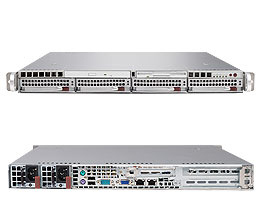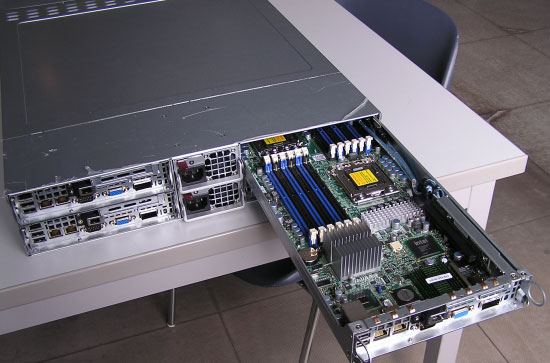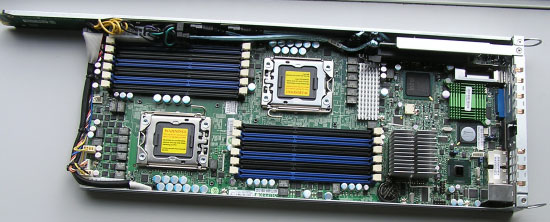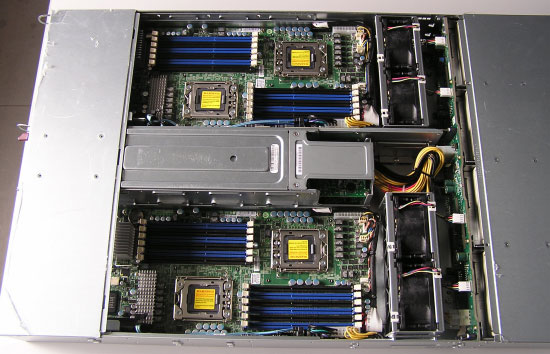Testing the latest x86 rack servers and low power server CPUs
by Johan De Gelas on July 22, 2009 2:00 AM EST- Posted in
- IT Computing
Lower Powered AMD Server: the A+ Server 1021M-UR
AMD does not make boards for commercial use and thus turns wisely towards a third party, in this case Supermicro. The H8DMU+, still based on the NVIDIA's MCP55Pro, is hardly optimized for low power. It is clear that the AMD platform really needs a refresh with some new modern HT3 (HyperTransport 3) capable low power chipsets. In a few weeks, the Fiorano platform should launch, but that does not mean the AMD based low power server does not have a chance. For example, the board offers no less than 16 DIMM slots and the server supports two redundant power supplies. Those two features alone make this server a lot more attractive to the virtualization crowd than the low power Chenbro + Willowbrook combination.

The server also allows one low profile and two full height expansion slots, which is rather exceptional for a 1U server. One of those two full height slots is Supermicro's proprietary UIO slot. The server is fed by highly efficient 650W power supplies in a redundant 1+1 configuration.
The Supermicro Twin2
This is the most innovative server of this review. Supermicro places four servers in a 2U chassis and feeds them with two redundant 1200W PSUs. The engineers at Supermicro have thus been able to combine very high density with redundancy - no easy feat. Older Twin servers were only attractive to the HPC world were computing density and affordable prices were the primary criteria. Thanks to the PSU redundancy, the Twin2 should provide better serviceability and appeal to people looking for a web, database, or virtualization server.

Most versions of this chassis support hot swappable server nodes, which makes the Twin2 a sort of mini-blade. Sure, you don't have the integrated networking and KVM of a blade, but on the flip side this thing does not come with TCO increasing yearly software licenses and the obligatory expensive support contracts.

By powering four nodes with a 1+1 PSU, Supermicro is able to offer redundancy and at the same time can make sure that the PSU always runs at a decent load, thus providing better efficiency. According to Supermicro, the 1200W power supplies can reach up to 93% efficiency. This is confirmed by the fact that the power supply is certified by the Electric Power Research Institute as an "80+ Gold" PSU with a 92.4% power efficiency at 50% load and 91.2% at 20% load. With four nodes powered, it is very likely that the PSU will normally run between these percentages. Power consumption is further reduced by using only four giant 80mm fans. Unfortunately, and this is a real oversight by Supermicro, as the fans are not easy to unplug and replace. We want hot swappable fans.

Supermicro managed to squeeze two CPUs and 12 DIMM slots on the tiny boards, which means that you can outfit each node with 48GB of relatively cheap 4GB DIMMs. Another board has a Mellanox Infiniband controller and connector onboard, and both QDR and DDR Infiniband are available. To top it off, Supermicro has chosen the Matrox G200W as a 2D card, which is good for those who still access their servers directly via KVM. Supermicro did make a few compromises: you cannot use Xeons with a TDP higher than 95W (who needs those 130W monsters anyway?), 8GB DIMMs seem to be supported only on a few SKUs right now, and there is only one low profile PCI-e x16 expansion slot.
The Twin2 chassis can be outfitted with boards that support Intel "Nehalem Xeons" as well as AMD "Istanbul Opterons". The "Istanbul version" came out while we were typing this and was thus not included in this review.










12 Comments
View All Comments
Photubias - Wednesday, July 22, 2009 - link
VMware recognizes the problem as being a reporting issue between the BIOS and ESX. It should be fixed by U1 of ESX4.More info here.
Photubias - Wednesday, July 22, 2009 - link
This is the correct link:http://kb.vmware.com/selfservice/microsites/search...">http://kb.vmware.com/selfservice/micros...=3100028...